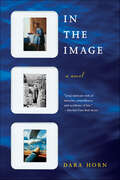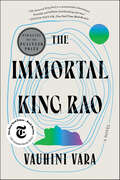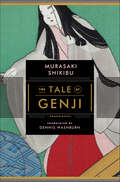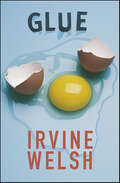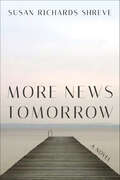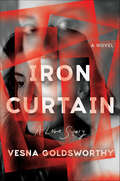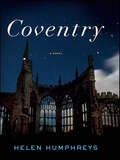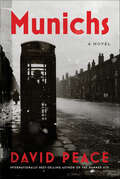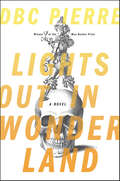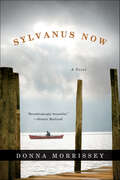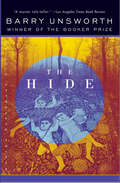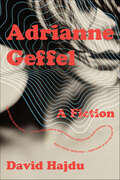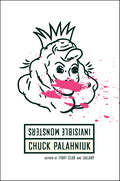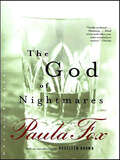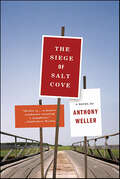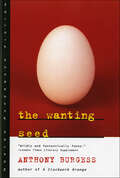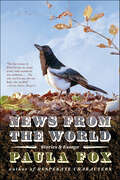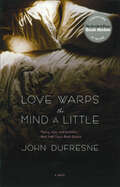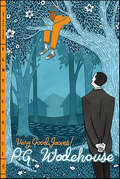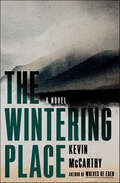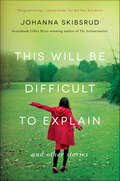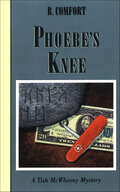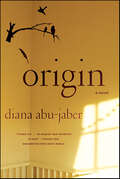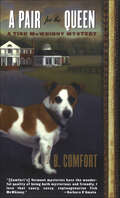- Table View
- List View
In the Image: A Novel
by Dara HornA young woman's coming of age, a romantic love story, and a spiritual journey—each infused with the lessons of history.In the Image is an extraordinary first novel illuminated by spiritual exploration, one that remembers "a language, a literature, a held hand, an entire world lived and breathed in the image of God." Bill Landsmann, an elderly Jewish refugee in a New Jersey suburb with a passion for travel, is obsessed with building his slide collection of images from the Bible that he finds scattered throughout the world. The novel begins when he crosses paths with his granddaughter's friend, Leora, and continues by moving forward through her life and backward through his, revealing the unexpected links between his family's past and her family's future. Not just a first novel but a cultural event—a wedding of secular and religious forms of literature—In the Image neither lives in the past nor seeks to escape it, but rather assimilates it, in the best sense of the word, honoring what is lost and finding, among the lost things, the treasures that can renew the present. Reading group guide included.
The Immortal King Rao: A Novel
by Vauhini VaraFinalist for the 2023 Pulitzer Prize in Fiction Nominated for the 2022 NBCC John Leonard Prize Named a Best Book of the Year by NPR, Esquire, Vox, Philadelphia Inquirer, and Literary Hub In an Indian village in the 1950s, a precocious child is born into a family of Dalit coconut farmers. King Rao will grow up to be the most accomplished tech CEO in the world and, eventually, the leader of a global, corporate-led government.In a future in which the world is run by the Board of Corporations, King’s daughter, Athena, reckons with his legacy—literally, for he has given her access to his memories, among other questionable gifts.With climate change raging, Athena has come to believe that saving the planet and its Shareholders will require a radical act of communion—and so she sets out to tell the truth to the world’s Shareholders, in entrancing sensory detail, about King’s childhood on a South Indian coconut plantation; his migration to the U.S. to study engineering in a world transformed by globalization; his marriage to the ambitious artist with whom he changed the world; and, ultimately, his invention, under self-exile, of the most ambitious creation of his life—Athena herself.The Immortal King Rao, written by a former Wall Street Journal technology reporter, is a resonant debut novel obliterating the boundaries between literary and speculative fiction, the historic and the dystopian, confronting how we arrived at the age of technological capitalism and where our actions might take us next.
The Tale of Genji: Unabridged (Tuttle Classics Of Japanese Literature Ser.)
by Murasaki Shikibu"A fluid, elegant rendition." —Washington PostMurasaki Shikibu, born into the middle ranks of the aristocracy during the Heian period (794–1185 CE), wrote The Tale of Genji—widely considered the world’s first novel—during the early years of the eleventh century. Expansive, compelling, and sophisticated in its representation of ethical concerns and aesthetic ideals, Murasaki’s tale came to occupy a central place in Japan’s remarkable history of artistic achievement and is now recognized as a masterpiece of world literature.The Tale of Genji is presented here in a flowing new translation for contemporary readers, who will discover in its depiction of the culture of the imperial court the rich complexity of human experience that simultaneously resonates with and challenges their own. Washburn sets off interior monologues with italics for fluid reading, embeds some annotations for accessibility and clarity, and renders the poetry into triplets to create prosodic analogues of the original.
Glue
by Irvine WelshAn epic novel about the bonds of friendship from the author of Trainspotting.The story of four boys growing up in the Edinburgh projects, Glue is about the loyalties, the experiences, and the secrets that hold friends together through three decades. The boys become men: Juice Terry, the work-shy fanny-merchant, with corkscrew curls and sticky fingers; Billy the boxer, driven, controlled, playing to his strengths; Carl, the Milky Bar Kid, drifting along to his own soundtrack; and the doomed Gally, exceedingly thin-skinned and vulnerable to catastrophe at every turn. We follow their lives from the seventies into the new century—from punk to techno, from speed to E. Their mutual loyalty is fused in street morality: Back up your mates, don't hit women, and, most important, never snitch—on anyone.Glue has the Irvine Welsh trademarks—crackling dialogue, scabrous set pieces, and black, black humor—but it is also a grown-up book about growing up; about the way we live our lives, and what happens to us when things become unstuck.
More News Tomorrow: A Novel
by Susan Richards Shreve“A well-tuned mandolin of a gothic adventure.” —Washington PostOn the morning of her seventieth birthday, Georgianna Grove receives an unexpected letter that calls her back to Missing Lake, Wisconsin, where her mother was murdered sixty-six years earlier. Georgie’s father had confessed to the murder the next morning and was carted off to a state penitentiary. Determined to unearth the truth, Georgie takes her reluctant family on what will become a dangerous canoe trip up the swollen Bone River to return to the campsite that has haunted her memories. Thrilling and richly drawn, More News Tomorrow follows a daughter’s quest to finally understand her parents’ fate.
Iron Curtain: A Novel
by Vesna GoldsworthyOne of The New Yorker's Best Books of 2023 East and West collide in a “timely” and “bittersweet tale of loyalty, love, and the siren call of freedom” (Rebecca Abrams, Financial Times).Milena Urbanska is a red princess living in a Soviet satellite state in the 1980s. She enjoys limitless luxury and limited freedom; the end of the Cold War seems unimaginable. When she meets Jason, a confident but politically naïve British poet, they fall into bed together. Before long, Milena is planning her escape. She follows Jason to London, where she’s shocked to find herself living in bohemian poverty. The rented apartment is dingy, the food disgusting, and Jason’s family withholding, but at least there are no hidden cameras recording her every move. As she adjusts to her new life, however, Milena discovers the dark side of Jason’s idea of freedom.With cool wit and tender precision, Vesna Goldsworthy delivers a razor-sharp vision of two worlds on the brink of change, amidst the failures of family and state. Iron Curtain is a sly, elegant comedy of manners that challenges the myths we tell ourselves.
Coventry: A Novel
by Helen Humphreys“Elegant . . . illuminates the impact of war on ordinary people . . . an elegy and a celebration.”—Ann Hood, author of The Knitting Circle On the evening of November 14, 1940, Harriet Marsh stands on the roof of the historic Coventry cathedral and marvels at the frost glittering beneath a full moon. But it is a bomber’s moon, and the Luftwaffe is coming to unleash destruction on the city. For Harriet; for the young fire watcher, Jeremy, standing beside her; and for his artist mother, Maeve, hiding in a cellar, this single night of horror will resonate for the rest of their lives. Coventry is a testament to the power of the human spirit, an honest and ultimately uplifting account of heartache transformed into compassion and love.
Munichs: A Novel
by David PeaceOne of The Week's Best novels of 2024 From the acclaimed author of The Damned Utd, a novel of tragedy and renewal, inspired by one of the greatest disasters in the history of sports.In 1958, Manchester United was flying high: the best-known soccer team in the world and reigning English champions, the team was led by a bright young group of star players nicknamed the “Busby Babes” after their charismatic manager Matt Busby. But on a snowy afternoon that February, a plane carrying the team back from a European Cup match crashed on takeoff in Munich, killing 23 people—including eight Manchester United players and three team officials. The accident destroyed the team, traumatized fans all over the world, and devastated the tight-knit community in Manchester.In this hypnotic and deeply moving novel, renowned novelist David Peace reimagines the crash and its aftermath, dramatizing the deep scars it left on British society. Moving between the fictionalized voices of survivors, including players, their family members, and Busby himself, Munichs powerfully interprets the struggles of a team, a city, and a nation to recover and rise again.Peace has been hailed as “brilliant” by Kazuo Ishiguro and his novels have been lauded as “incantatory” (Los Angeles Times), “ambitious and heartbreaking” (NPR), and “the stuff of great literature” (New York Times Book Review). With Munichs, he has crafted another extraordinary novel, one that intimately explores the reverberations of trauma and the power of community in the wake of tragedy.
Twilight Territory: A Novel
by Andrew X. PhamA New Yorker Best Book of 2024 A sweeping first novel of love, war, and resistance in post–World War II Vietnam, by the award-winning author of Catfish and MandalaThe peak of the hot season, 1942: The wars in Europe and Asia and the Japanese occupation have upset the uneasy balance of French Indochina. In the Vietnamese fishing village of Phan Thiet, Tuyet ekes out a living at a small storefront with her aunt Coi, her cousin Ha, and her two-year-old daughter, Anh. She can hardly remember her luxurious life in the city of Saigon, which she left just two years ago.The day Tuyet meets Japanese major Yamazaki Takeshi is inauspicious and stifling, with no relief from the sand-stirring wind. But to her surprise, she feels not fear or wariness, but a strange kinship. Tuyet is guarded, knowing how the townspeople might whisper, yet is drawn to Takeshi’s warmth all the same. A wounded veteran with a good heart, Takeshi grows to resent the Empire for what it has taken—and the promises it has failed to keep. As the Viet Minh begin to battle the French and Takeshi risks his life for the Resistance, Tuyet and her family are drawn into the conflict, with devastating consequences.A lushly panoramic novel, by turns gritty and profoundly moving, Twilight Territory is at once a war story and a love story that offers a fascinating perspective on Vietnam’s struggles to break free of its French colonial past. At its heart is one woman’s struggle for independence and her country’s liberation.
Lights Out in Wonderland: A Novel
by DBC Pierre"Lights Out in Wonderland has all the verbal wit and energy of Vernon God Little."—Financial Times Gabriel Brockwell—aesthete, philosopher, disaffected twenty-something decadent—is thinking terminal. He's decided to kill himself—but not immediately. His destination is Wonderland. The style of the journey is all that's to be decided. Traveling between London, Tokyo, and Berlin, Gabriel is in search of the bacchanal to obliterate all previous parties. His adventure takes in a spell in rehab, a near-death experience eating a poisonous Japanese delicacy, and finally an orgiastic feast in the bowels of Berlin's majestic Tempelhof Airport. Along the way, Gabriel falls apart, only to reemerge with a new outlook on the world and a mission to right his past wrongs.Lights Out in Wonderland is an allegorical banquet, a sly commentary on these End Times and the march toward banality, and a joyful expression of the human spirit.
Sylvanus Now: A Novel
by Donna Morrissey"Breathtakingly beautiful." —Alistair MacLeodOn the coast of the great, 1950s Newfoundland fishing banks, Sylvanus Now is a rugged fisherman who treasures the traditions of his small village and his time alone with the vast sea. But when he sees Adelaide, a fiery, proud beauty from a neighboring outport, he is mesmerized and steadily pursues her. Adelaide dreams of escaping across the seas and becoming a missionary, but she is more eager to escape her squealing young brothers and sisters. She soon marries Sylvanus, and the mismatched couple is forced to face one of the great environmental catastrophes of our time: the collapse of the largest fishing grounds on earth.Through this story of love, loss, and transformation in a dissolving community, Donna Morrissey plumbs the depths of authentic relationships and breathes potent life into the ravaged Newfoundland landscape.
The Hide
by Barry UnsworthThis early work by the Booker Prize-winning author Barry Unsworth chronicles one of his literary obsessions the corruption of innocence and forms it into a compelling contemporary narrative set in the rambling, overgrown grounds of an English estate. There, relying on his rich sister Audrey's beneficence, Simon obsessively digs a secret system of tunnels from which to spy on others. When Josh, a good-looking naif, becomes a gardener at Audrey's home, the two women of the household, Audrey and her distant relative and housekeeper, Marion, find Josh's strength and seeming innocence a potent spell, and his response escalates unacknowledged tensions between them. Meanwhile, Simon, worried about Josh, takes steps to prevent the exposure of his underground labyrinth. The explosive chemistry between the characters will eventually rip apart and rearrange all their lives.
Adrianne Geffel: A Fiction
by David HajduThis never-before-told story of the life and work of a (fictitious) musical phenomenon is "a revealing—and at times hilarious—satire of the music business, fame, and the cult of personality" (Clea Simon, Boston Globe).Adrianne Geffel was a genius. Praised as the “Geyser of Grand Street” and the “Queen of Bleak Chic,” she was a one-of-a-kind artist, a pianist and composer with a rare neurological condition that enabled her to make music that was nothing less than pure, unmediated emotional expression. She and her sensibility are now fully integrated into the cultural lexicon; her music has been portrayed, represented, and appropriated endlessly in popular culture. But what do we really know about her? Despite her renown, Adrianne Geffel vanished from public life, and her whereabouts remain a mystery to this day.David Hajdu cuts through the noise to tell, for the first time, the full story of Geffel’s life and work, piecing it together through the memories of those who knew her, inspired her, and exploited her—her parents, teachers, best friend, manager, critics, and lovers. Adrianne Geffel made music so strange, so compelling, so utterly unique that it is simply not to be believed. Hajdu has us believing every note of it in this slyly entertaining work of fiction.A brilliantly funny satire, with characters that leap off the page, Adrianne Geffel is a vividly twisted evocation of the New York City avant-garde of the 1970s and ’80s, and a strangely moving portrait of a world both utterly familiar and like none we’ve ever encountered.
Invisible Monsters
by Chuck Palahniuk"A harrowing, perverse, laugh-aloud funny rocket ride." —Seattle Times Injected with new material and special design elements, Invisible Monsters Remix fulfills Chuck Palahniuk’s original vision for his 1999 novel, turning a daring satire on beauty and the fashion industry into an even more wildly unique reading experience. Palahniuk’s fashion-model protagonist has it all—boyfriend, career, loyal best friend—until an accident destroys her face, her ability to speak, and her self-esteem. Enter Brandy Alexander, Queen Supreme, one operation away from becoming a bona-fide woman. Laced in are new chapters of memoir and further scenes with the book’s characters. Readers will jump between chapters, reread the book to understand the dissolve between fiction and fact, and decipher the playful book design, embarking on a ride they’ll never forget.
The God of Nightmares: A Novel
by Paula Fox"Vividly rendered…haunting…[Paula Fox] writes with silken ease and a sensitivity to nuance." —NewsdayIn 1941, twenty-three-year-old Helen Bynum leaves home for the first time and sets out from rural New York to find her Aunt Lulu, an aging actress in New Orleans. There she finds a life of passion and adventure, possibilities and choices. Falling in with a bohemian group of intellectuals, she discovers romance and sex, friendship and risk, her world mirrored by the steamy mystery of the French Quarter.
The Siege of Salt Cove: A Novel
by Anthony Weller"A gloriously strange book, both whimsical and brooding."—Jeremy Jackson, People The Commonwealth of Massachusetts has decided to replace Salt Cove's signature wooden bridge with a concrete monstrosity. The authorities are unreasoning and unyielding. The town decides on secession. Jessica Stoddard is a quirky seventy-two-year-old who is determined to keep a record of the event for posterity. She has a passion for the truth, but her account is not entirely reliable, because she also has a passion for the rebellion's ringleader who is...well, a much younger man. Toby Auberon is a lawyer and a drop-out. He has returned after years in Rio to perfect his mysterious invention in the solitude of the lighthouse. He is drawn, unwillingly, into the dispute when the bureaucracy switches tactics from bullying to armed occupation. Powerful, poignant, deeply funny, and enriched by the villagers' diverse voices, this is a contemporary farce about a town that dares to rebel against its own government, and to fight back when attacked.
The Wanting Seed
by Anthony BurgessSet in the near future, The Wanting Seed is a Malthusian comedy about the strange world overpopulation will produce. Tristram Foxe and his wife, Beatrice-Joanna, live in their skyscraper world where official family limitation glorifies homosexuality. Eventually, their world is transformed into a chaos of cannibalistic dining-clubs, fantastic fertility rituals, and wars without anger. It is a novel both extravagantly funny and grimly serious.
News from the World: Stories & Essays
by Paula Fox“Not only can Fox see, she can hear, she can feel.”—Zadie Smith, Harper’s This gathering of Paula Fox’s short work spans her illustrious career, from 1965 to the present including perfectly turned stories; pointed, engaging essays; and raw yet eloquent memoir.
Love Warps the Mind a Little: A Novel
by John DufresneReissue of a favorite novel by “a generous and lyric storyteller” (San Francisco Chronicle) known for his tragicomic voice and unforgettable characters. Ever since Lafayette Proulx quit his day job, left his wife, hauled his dog and his Royal portable across town to Judi Dubey’s house, and set out at last to be a fiction writer, his life has been a sordid mess. Judi’s exotically dysfunctional family isn’t all to blame. Sure, the murders are disconcerting. And, yes, Judi’s father’s gone off the deep end. Worse are the vicious rejection letters Laf gets from editors. To top it off, Laf’s falling for Judi at the same time he’s nettled with guilt, is in marriage counseling with his wife, and is writing his long-hoped-for novel. When Judi is diagnosed with stage IV cancer, they both struggle to find the memory that will comfort, the truth that will redeem in a world where everyone suffers some kind of love disorder. John Dufresne, called “a highly readable Faulkner,” will once again take the literary world by storm with this new tragicomic tale.
Very Good, Jeeves! (Jeeves and Wooster)
by P. G. Wodehouse“To dive into a Wodehouse novel is to swim in some of the most elegantly turned phrases in the English language.”—Ben Schott Follow the adventures of Bertie Wooster and his gentleman’s gentleman, Jeeves, in this stunning new edition of one of the greatest comic short story collections in the English language. Whoever or whatever the cause of Bertie Wooster's consternation—Bobbie Wickham giving away his fierce Aunt Agatha's dog; getting into the bad books of Sir Roderick Glossop; attempting to scupper the unfortunate infatuation of his friend Tuppy for a robust opera singer—Jeeves can always be relied on tyo untangle the most ferocious of muddles. Even Bertie's.
The Wintering Place: A Novel
by Kevin McCarthyDeserting to escape the horrors of the Indian wars two soldiers, Irish brothers, seek peace with the woman they love.Dakota Territory, 1867. The O’Driscoll brothers have survived a Sioux massacre, but Michael is gravely wounded. The deserters are fleeing north with Tom’s lover, Sara, when they come upon a sheltering rock by a river down off the Bozeman trail. If there is game here, they may survive the winter. But their attempts to find food and endure the savage winter are threatened by the arrival in their camp of two trappers, whose presence sets in motion a series of bloody events that will mark the trio as Outlaws, hunted by the Montana Vigilance Committee, their likenesses appearing on Wanted posters in settlements and mining camps along the trail. Enter any town, and they will have to shoot their way out. The rock and the river become their safe place, and when spring comes, their paradise. But the world seeks its way to them, and even in paradise human nature makes its own trouble. In this follow-up to his acclaimed novel, Wolves of Eden, Kevin McCarthy tells a story of three very human characters battling to survive in a vast, beautiful, and unforgiving landscape.
This Will Be Difficult to Explain: And Other Stories
by Johanna SkibsrudNine loosely connected, hypnotic stories about memory and desire showcase one of fiction's bright new voices. In the Scotiabank Giller Prize–winning author Johanna Skibsrud’s new book, nine loosely connected and hypnotic stories introduce an unforgettable cast of characters. A young maid at a hotel in France encounters a man who asks to paint her portrait, only later discovering that the man is someone other than who she thinks. A divorced father, fearing estrangement from his thirteen-year-old daughter, allows her to take the wheel of his car, realizing too late that he’s made a grave mistake. A Canadian girl and her French host stumble on the one story that transcends their language barrier. Youth confronted with the mutterings of old age, restlessness bounded by the muddy confines of a backyard garden, callow hope coming up against the exigencies of everyday life—these are life-defining moments that weave throughout the everyday lives of the remarkable characters in this book. Time and again they find themselves confronted with what they didn’t know they didn’t know, at the exact point of intersection between impossibility and desire. In This Will Be Difficult to Explain Skibsrud has created a series of masterful, perceptive tales.
Phoebe's Knee (Tish McWhinny Mysteries)
by B. Comfort"Tish McWhinny is Miss Marple without the cuteness, brought up to date and plunked down in Vermont. She is gutsy and audacious...." --Margaret MaronWhen B. Comfort's The Cashmere Kid appeared in 1993, Publishers Weekly wrote, "Vermont goat-herding may not sound like material for a gripping mystery, but in Comfort's hands it achieves that dimension." Now readers who missed the earlier adventures of Tish McWhinny can enjoy the very first, also set in the pristine, picture-perfect village of Lofton.The tranquility of this southern Vermont haven is disturbed, however, when Tish's newest neighbor arrives and proves to be an entire cult. Calling itself The Ring of Right, its intent and purposes are anything by apparent.Tish first senses that something is odd when a young reporter arrives to write an article on the "Ringers" and promptly disappears. Then, walking in the woods, Tish tumbles into what on examination seems to be an ancient Druid cave. By the time the inevitable murder takes place and Tish herself looks like the suspect, the little town has been transformed into a hotbed of intrigue.
Origin: A Novel
by Diana Abu-Jaber"Finally, a novel of literary suspense that gets almost everything right—forensically and psychologically." —Sarah Weinman, Baltimore SunSecretly, in her heart of hearts, Lena Dawson hides the strangest of beliefs about her childhood. Hiding behind a cool competence as a superb fingerprint analyst in a crime lab in snowy Syracuse, New York, she feels totally out of place in the ordinary world of human interaction. Especially since the controlling husband who guided and protected her, then cheated and left her (though now he wants her back). Her uncanny ability to read a crime scene draws her into investigating a mysterious series of crib deaths—but ultimately the most difficult puzzle she must solve is the one of her own origins.Diana Abu-Jaber, a “gifted and graceful writer” (Chicago Tribune), masterfully “transcends formula” (Kirkus Reviews) as “the tension of Origin escalates, shaped as much by beautifully nuanced prose as menacing events” (New York Daily News).
A Pair for the Queen (Tish McWhinny Mysteries)
by B. ComfortThe enterprising Vermont sleuth Tish McWhinny — whom Booklist calls "an absolutely first-rate companion" — returns in her fifth Vermont mystery, on the trail of a murderer at a local dog show. Tish McWhinny reluctantly gets involved in restoring an old painting for a dog show promotion — harmless enough, but then the painting is stolen and someone is murdered. Is the crime connected to the rather shady new couple now running the local store? What about the retired Royal Navy man, now much interested in art, who unexpectedly turns up? Or niece Sophie's secretive new boyfriend? It takes all Tish's ingenuity, as well as the help of her courtly friend Hilary Oats and free-spirit Sophie, to find out what's going on and catch a cold criminal. "Lofton, Vermont, is a place I'd like to live — right next door to Tish McWhinny, if possible. Barbara Comfort's Vermont mysteries have the wonderful quality of being both mysterious and friendly. I love that saucy, sassy, septuagenarian Tish McWhinny." — Barbara D'Amato
